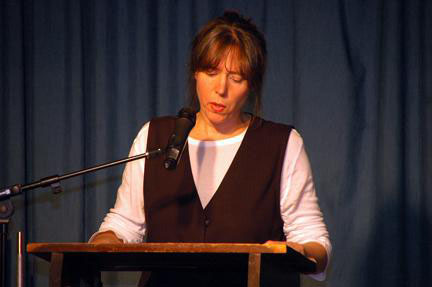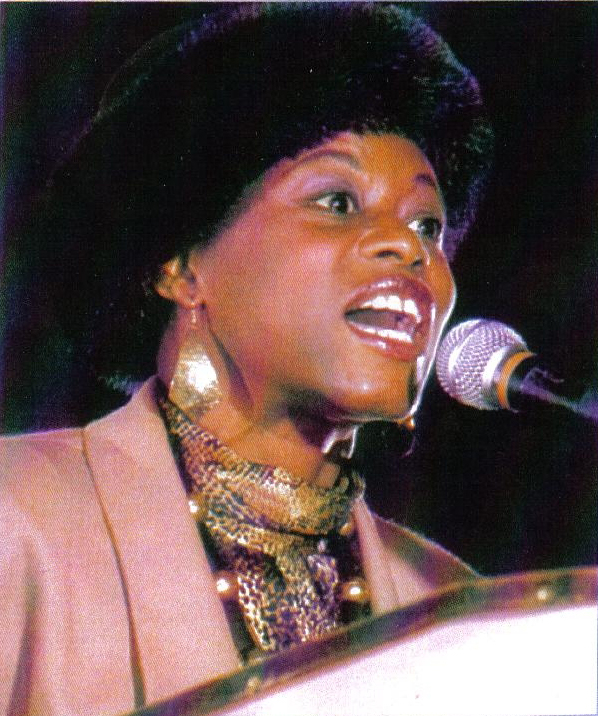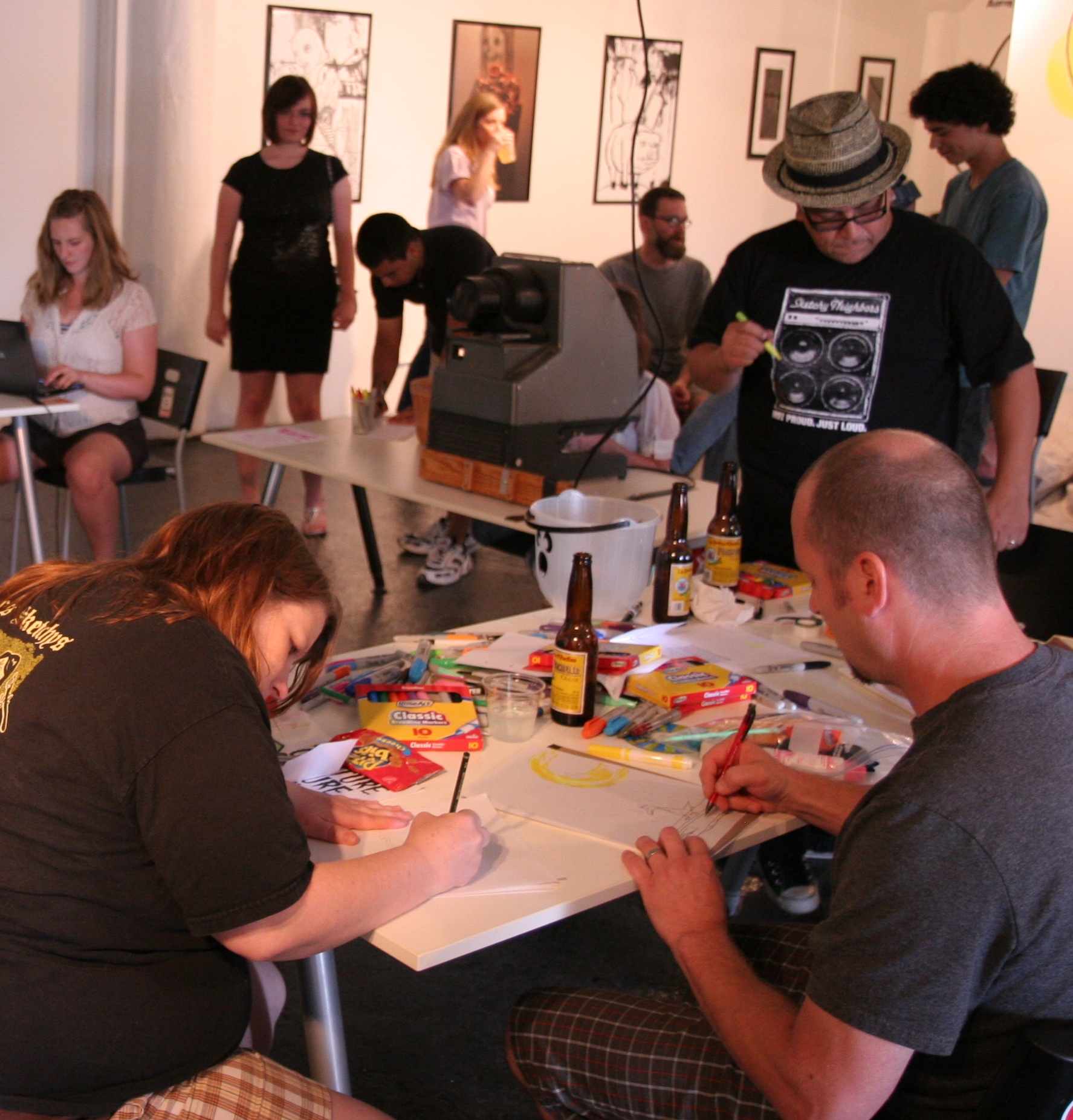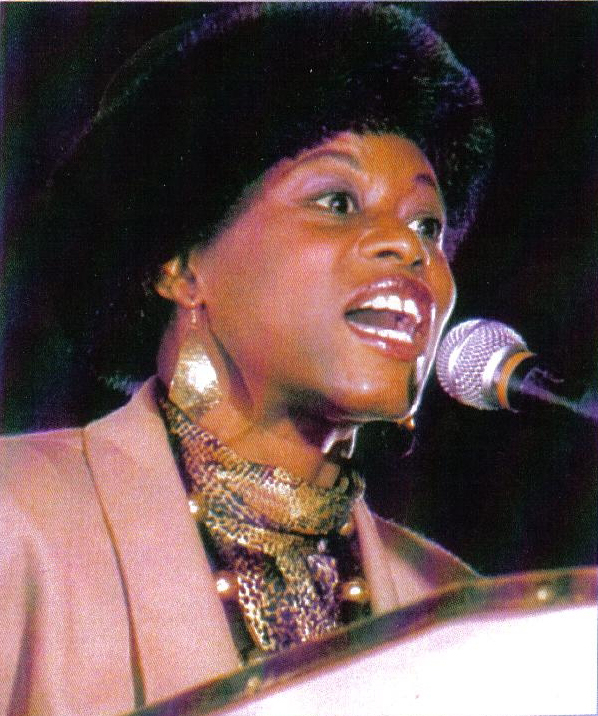Natalie Diaz
The NewsHour's Jeffrey Brown recently spent some time with poet Natalie Diaz, author of the collection When My Brother Was an Aztec (Copper Canyon Press, 2012), who is working to preserve the rapidly disappearing Mojave language.
Jump to navigation Skip to content
The NewsHour's Jeffrey Brown recently spent some time with poet Natalie Diaz, author of the collection When My Brother Was an Aztec (Copper Canyon Press, 2012), who is working to preserve the rapidly disappearing Mojave language.
In a 2008 Paris Review interview with Kay Ryan, she explains her neologism “recombinant rhyme”—a craft technique of stashing “rhymes at the wrong ends of lines and in the middle.” According to Ryan, “snipping up pieces of sound and redistributing them throughout a poem” allows her to “get the poem to go a little bit luminescent.” Take a poem of yours that could use more musicality, and revise it to include recombinant rhyme.
Choose one of your poems that needs revision. Give it to five friends and ask each of them to create an audio version of it by reading it into your telephone answering machine or recording themselves reading it and sending you the audio file. Listen to the five audio versions for places where the rhythm or musical qualities of the poem fall away or sound flat. Use these readings to revise the poem.
Cara Benson, author of poetry book (made)and the forthcoming "Funny. Considering how heated it was," and receipient of a Poetry Fellowship from the New York Foundation for the Arts, blogs about teaching poetry at the Mt. McGregor Correctional Facility.
The poetry workshop I facilitate at Mt. McGregor Correctional Facility, a medium security state prison in Wilton, New York, began as a three month teaching practicum for my graduate degree. It became clear fairly quickly that three months wasn’t nearly enough to meet the interest and needs of the students inside. So we extended it to four months. Then five. Then a year. Now it’s been seven years and counting.
 In that time we have covered such varied poets as Lu Chi, Rumi, Sappho, Amiri Baraka, Federico García Lorca, T.S. Eliot, Sonia Sanchez, EE Cummings, Audre Lorde, Muriel Rukeyser, LaTasha N. Nevada Diggs, Alice Notley, Gil Scott-Heron, and CA Conrad. The list is growing like the years. Dozens of men - maybe a hundred - have come to and through the class. Some on the outside are now proud graduates of Higher Education. On the inside, a few lifers have been there since my first day. I have seen many things happen in that classroom, but fostering the dissolution of preconceived notions of what can be called “poetry” under the influence of poems like Joan Retallack’s “A I D /I/ S A P P E A R A N C E” or Douglas Kearney’s page work is particularly gratifying. I’ve seen, like realizing blondes aren’t the only beauties, the canon explode in front of our faces, and I tell you that this is a very right thing to be happening inside.
In that time we have covered such varied poets as Lu Chi, Rumi, Sappho, Amiri Baraka, Federico García Lorca, T.S. Eliot, Sonia Sanchez, EE Cummings, Audre Lorde, Muriel Rukeyser, LaTasha N. Nevada Diggs, Alice Notley, Gil Scott-Heron, and CA Conrad. The list is growing like the years. Dozens of men - maybe a hundred - have come to and through the class. Some on the outside are now proud graduates of Higher Education. On the inside, a few lifers have been there since my first day. I have seen many things happen in that classroom, but fostering the dissolution of preconceived notions of what can be called “poetry” under the influence of poems like Joan Retallack’s “A I D /I/ S A P P E A R A N C E” or Douglas Kearney’s page work is particularly gratifying. I’ve seen, like realizing blondes aren’t the only beauties, the canon explode in front of our faces, and I tell you that this is a very right thing to be happening inside.
Last month we read Harryette Mullen’s Muse & Drudge and discerned a number of tactics worth replicating. The participants loved her multiple voices, taut quatrains, and ability to twist common sayings into such rhythmic, flipped scripts. This month we are working with Rob Budde’s Declining America. There is a section in this book that plays out in scenes he’s called “My American Movie” after Jean Baudrillard’s America. So we are writing our own American scenes under the influence of his text. His poems gyrate without punctuation and stream as one undulating and pullulating sentence in prose, and the task I’ve given us of emulating his approach has proven provocative and productive.
Eric Perez, one of the participants, has this to say about the class: “Our poetry workshop has given us a unique opportunity to liberate ourselves from an oppressive system, even if only for a brief time during the week. This helps us to reach a broader understanding of life and its circumstances and to push the boundaries of our intellect in order to build our self esteem.” I am very grateful to Poets & Writers for the support it gives for the class. It can be really challenging, the proverbial upstream swim, to be a volunteer poet for the New York State Department of Corrections. Poets & Writers not only provides remuneration, but it legitimizes the endeavor. It truly has helped me to show up week after week, year after year. And as the late poet and tireless prison educator/activist Janine Pommy Vega used to say to me whenever I complained about a seeming setback or “lost” student: “Cara, you just keep going in.” So I do.
Photo: Cara Benson. Credit: David Brinson.
Support for Readings/Workshops in New York is provided, in part, by public funds from the New York State Council on the Arts, with additional support from the Friends of Poets & Writers.
Poet and educator Carole "Imani" Parker blogs about her former student "Donald" at the P&W–supported Jobs for Youth Apprenticeship Program (JFYAP) at Medgar Evers College, a job readiness program she once directed.
"Donald" was a withdrawn seventeen-year-old boy when he came to JFYAP. His reading and math scores were extremely low and he had very low self-esteem. He had been expelled from high school, two General Educational Development (GED) programs, and was eventually expelled from the GED component of JFYAP for threatening another student. With the help JFYAP coordinator, Ms. B, "Donald" was able to enroll in a computer training course and continued to attend JFYAP job readiness/life skills training, counseling, tutoring and P&W–supported poetry workshops.

Although JFYAP is now defunct, I, with Ms. B, continue to follow up with and encourage "Donald." As a matter of fact, I spoke with "Donald" the other day. He said that he completed the computer course and received a certificate. He also plans to take the GED soon and is excited about participating in P&W's annual intergenerational reading later this month. Here are the first two lines from "What am I," a poem he hopes to read at the event: I am the sound that is heard from a mile away / I am that name you hear them whisper in the wind.
"Donald’s" story is not unique. There were many troubled and talented young people who walked through the doors of JFYAP. Most of them eventually passed the high school regents or GED exam and went on to college and, later, careers. JFYAP provided them with the necessary tools to become productive citizens.
Photo: Carole Imani Parker.
Support for Readings/Workshops in New York City is provided, in part, by public funds from the New York State Council on the Arts, and the Department of Cultural Affairs, with additional support from the Louis & Anne Abrons Foundation, the Axe-Houghton Foundation, the A.K. Starr Charitable Trust, and Friends of Poets & Writers.
"Helps us to believe / That it’s no great sin to give, / Hoping to receive," writes Richard Wilbur in this poem, read by the iPhone-wielding video artist Faith Eskola's five-year-old child and brought to life by Motionpoems.
Poet Wayne Miller once compared reading a poem in translation to “watching a film with the sound turned down.” Find two or more English translations of a poem originally written in a foreign language with which you’re not familiar. Compare the translations, and try to “re-translate” the original poem based on the various English translations you’ve read.
While essentially a promo for the largest general-interest trade book publisher in the world, this clip does offer a valuable look at the jobs of a few of the many people who work at Random House, from editorial and design through production, marketing, sales, and distribution.
K.C. Scharnberg, program director of Fresh Arts, a multidisciplinary arts service organization in Houston, Texas, shares her thoughts on its P&W–supported Inky Improv event and the Houston literary scene.
What makes your organization unique?
Fresh Arts hosts professional development and networking events for artists in all fields and at all skill levels. We strive to support the professional growth of Houston’s art community and help make the starving artist a cliché of the past.
 What recent project have you been especially proud of?
What recent project have you been especially proud of?
My favorite event sprang from a quirky idea to pair unlikely yet complementary groups of artists. With support from P&W, we hosted Inky Improv, an event that paired the visual arts group Sketchy Neighbors with the writers group NANO Fiction.
Four writers and four artists each got a five-word phrase suggested by an audience member. They had ten minutes to draw or write something inspired by the prompt. If the prompt began with an artist, they handed their work over to a writer, and vice versa. Each person created a story or drawing to finish the piece over the next ten minutes. When the clock stopped, each writer and artist took turns presenting the final creations.
It was an exceptionally fun night, and we hope it becomes an annual event.
How do you cultivate an audience?
We provide a strong network for local artists online in our Artist Registry and off-line with our programs and services. We pay close attention to what’s happening in the community and reach artists working in all disciplines. In addition, we strive to offer relevant and high-quality programs and services based on feedback (surveys and personal conversations) from the artist community. When people feel like a company listens and responds to them, they tend to be more loyal.
What do you consider to be the value of literary programs for your community?
In the same way that a piece of music or art can bring out deep emotion from a person, literature can stimulate the senses in a way that creates a more fulfilling life experience.
Houston has a rich literary community and audiences that truly appreciate what literary programs contribute to our culture. For example, the Poison Pen Reading Series is a monthly series that takes place at a local bar and is enormously popular. It draws in all kinds of people and celebrates literature, while making it less intimidating and more accessible.
Writers in the Schools, one of my favorite organizations, engages children in the pleasure and power of reading and writing through in-school and after-school programs, professional development for teachers, and community programs celebrating the great work and development of the youth with whom they work. They have impacted the community in a major way over the years.
Additionally, the University of Houston’s Creative Writing Program is one of the best in the country, which is a source of pride amongst the literary-loving community. We are fortunate enough to benefit from the groundswell of literary contributions from the students, faculty, and graduates who choose to make Houston their home.
Photo: Inky Improv participants at work. Credit: Fresh Arts.
Support for Readings/Workshops events in Houston is provided by an endowment established with generous contributions from the Poets & Writers Board of Directors and others. Additional support comes from the Friends of Poets & Writers.
Poet, educator, and inspirational speaker Carole "Imani" Parker blogs about her former students at the P&W–supported Jobs for Youth Apprenticeship Program (JFYAP) at Medgar Evers College, a job readiness program she once directed.
In addition to classroom instructions, JFYAP students were engaged in exciting educational and recreational activities, such as college tours, United Nations forums, job shadowing, peer counseling, community service activities, entrepreneurial training, job readiness and life skills training, and, most importantly, P&W-supported poetry readings and workshops and participating in P&W's annual intergenerational poetry showcase.
 Because of their participation in JFYAP, many of the students have graduated from post secondary colleges or apprenticeship training programs and have entered successful careers as health care providers, teachers, social workers, accountants, production assistants, entertainers, etc.
Because of their participation in JFYAP, many of the students have graduated from post secondary colleges or apprenticeship training programs and have entered successful careers as health care providers, teachers, social workers, accountants, production assistants, entertainers, etc.
JFYAP students have benefited and grown as a result of all of the training they've received. They have received a well-rounded education, complete with P&W-supported poetry workshops.
Photo: Carole Imani Parker.
Support for Readings/Workshops in New York City is provided, in part, by public funds from the New York State Council on the Arts, and the Department of Cultural Affairs, with additional support from the Louis & Anne Abrons Foundation, the Axe-Houghton Foundation, the A.K. Starr Charitable Trust, and Friends of Poets & Writers.